Improving UK Manufacturing Culture: Innovation and Leadership Study
VerifiedAdded on 2023/06/13
|9
|1872
|389
Project
AI Summary
This research project aims to identify the importance of innovation and leadership in improving the organizational culture of UK manufacturing, focusing on SUPADANCE as a case study. The research objectives include increasing awareness of organizational culture, innovation, and leadership, determining the significance of innovation in improving organizational culture, ascertaining the role of leadership in changing organizational culture, and determining the relationship between leadership, innovation, and organizational culture. The research employs an interpretive philosophy and an inductive approach, utilizing secondary data sources such as books, articles, and publications. The project addresses ethical considerations related to data collection, informed consent, confidentiality, and data protection, ensuring participant rights and researcher safety. It includes sections on recruitment, consent, data management, and anticipated data use, emphasizing GDPR compliance and ethical research practices. This project highlights the critical role of innovation and leadership in shaping a positive and effective organizational culture within the UK manufacturing industry, as available on Desklib.
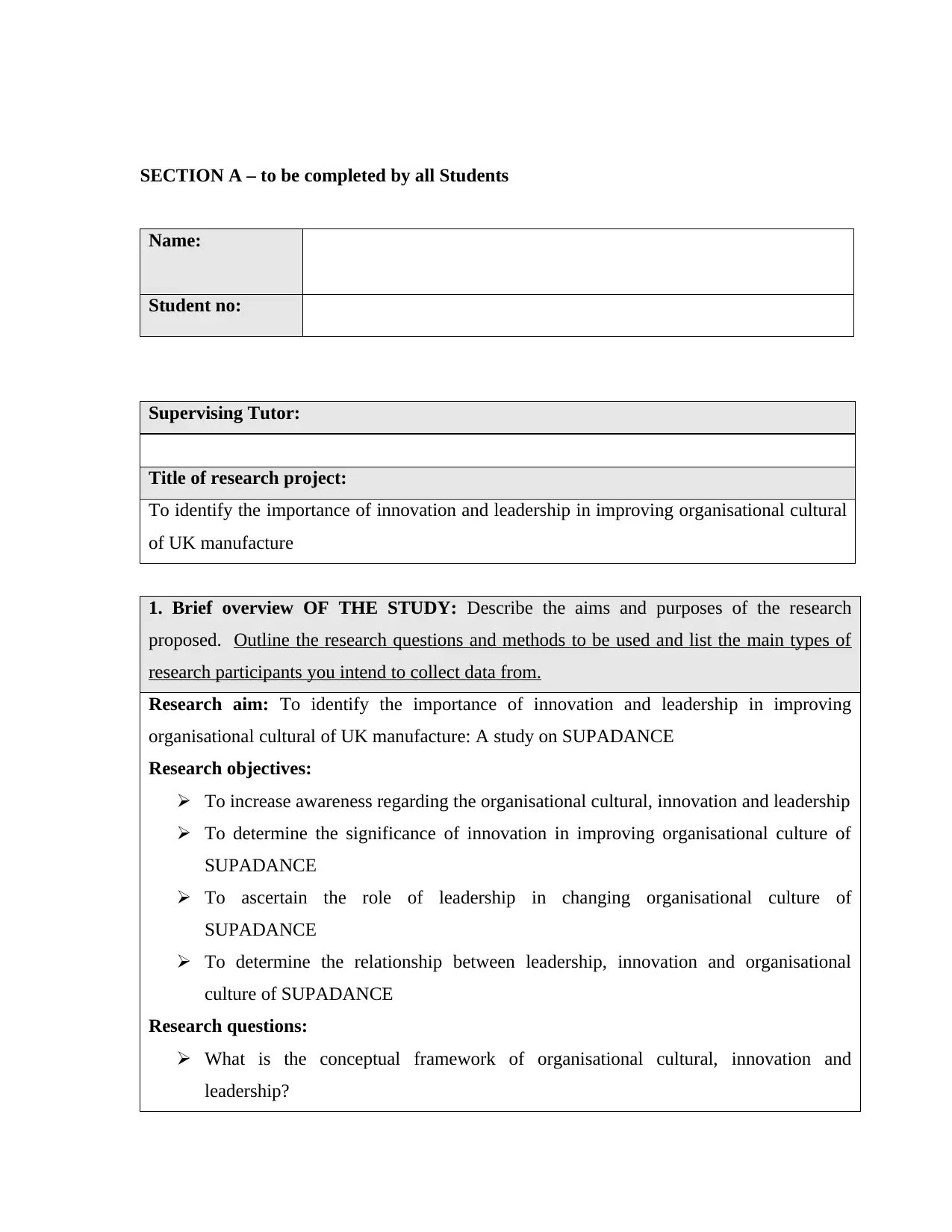
SECTION A – to be completed by all Students
Name:
Student no:
Supervising Tutor:
Title of research project:
To identify the importance of innovation and leadership in improving organisational cultural
of UK manufacture
1. Brief overview OF THE STUDY: Describe the aims and purposes of the research
proposed. Outline the research questions and methods to be used and list the main types of
research participants you intend to collect data from.
Research aim: To identify the importance of innovation and leadership in improving
organisational cultural of UK manufacture: A study on SUPADANCE
Research objectives:
To increase awareness regarding the organisational cultural, innovation and leadership
To determine the significance of innovation in improving organisational culture of
SUPADANCE
To ascertain the role of leadership in changing organisational culture of
SUPADANCE
To determine the relationship between leadership, innovation and organisational
culture of SUPADANCE
Research questions:
What is the conceptual framework of organisational cultural, innovation and
leadership?
Name:
Student no:
Supervising Tutor:
Title of research project:
To identify the importance of innovation and leadership in improving organisational cultural
of UK manufacture
1. Brief overview OF THE STUDY: Describe the aims and purposes of the research
proposed. Outline the research questions and methods to be used and list the main types of
research participants you intend to collect data from.
Research aim: To identify the importance of innovation and leadership in improving
organisational cultural of UK manufacture: A study on SUPADANCE
Research objectives:
To increase awareness regarding the organisational cultural, innovation and leadership
To determine the significance of innovation in improving organisational culture of
SUPADANCE
To ascertain the role of leadership in changing organisational culture of
SUPADANCE
To determine the relationship between leadership, innovation and organisational
culture of SUPADANCE
Research questions:
What is the conceptual framework of organisational cultural, innovation and
leadership?
Paraphrase This Document
Need a fresh take? Get an instant paraphrase of this document with our AI Paraphraser
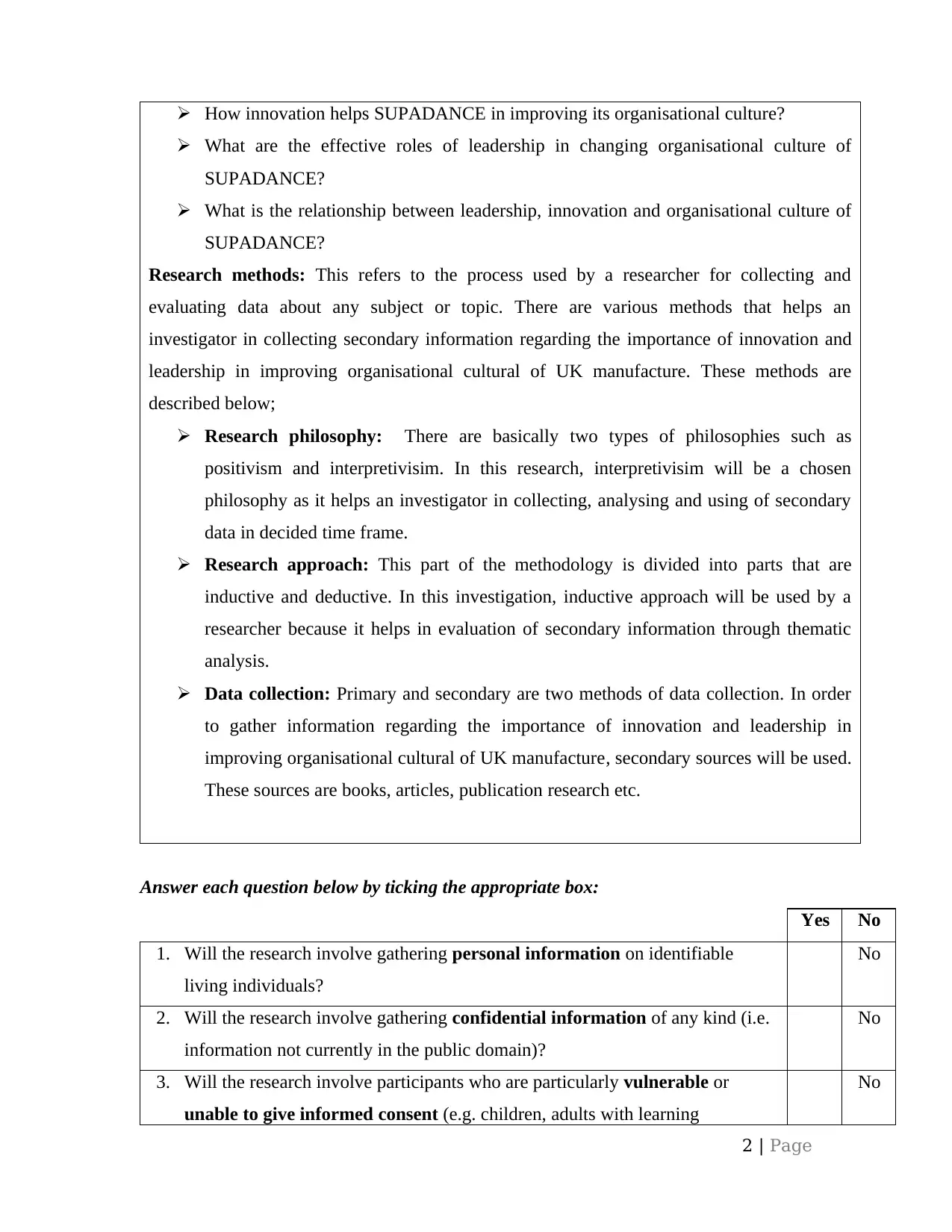
How innovation helps SUPADANCE in improving its organisational culture?
What are the effective roles of leadership in changing organisational culture of
SUPADANCE?
What is the relationship between leadership, innovation and organisational culture of
SUPADANCE?
Research methods: This refers to the process used by a researcher for collecting and
evaluating data about any subject or topic. There are various methods that helps an
investigator in collecting secondary information regarding the importance of innovation and
leadership in improving organisational cultural of UK manufacture. These methods are
described below;
Research philosophy: There are basically two types of philosophies such as
positivism and interpretivisim. In this research, interpretivisim will be a chosen
philosophy as it helps an investigator in collecting, analysing and using of secondary
data in decided time frame.
Research approach: This part of the methodology is divided into parts that are
inductive and deductive. In this investigation, inductive approach will be used by a
researcher because it helps in evaluation of secondary information through thematic
analysis.
Data collection: Primary and secondary are two methods of data collection. In order
to gather information regarding the importance of innovation and leadership in
improving organisational cultural of UK manufacture, secondary sources will be used.
These sources are books, articles, publication research etc.
Answer each question below by ticking the appropriate box:
Yes No
1. Will the research involve gathering personal information on identifiable
living individuals?
No
2. Will the research involve gathering confidential information of any kind (i.e.
information not currently in the public domain)?
No
3. Will the research involve participants who are particularly vulnerable or
unable to give informed consent (e.g. children, adults with learning
No
2 | Page
What are the effective roles of leadership in changing organisational culture of
SUPADANCE?
What is the relationship between leadership, innovation and organisational culture of
SUPADANCE?
Research methods: This refers to the process used by a researcher for collecting and
evaluating data about any subject or topic. There are various methods that helps an
investigator in collecting secondary information regarding the importance of innovation and
leadership in improving organisational cultural of UK manufacture. These methods are
described below;
Research philosophy: There are basically two types of philosophies such as
positivism and interpretivisim. In this research, interpretivisim will be a chosen
philosophy as it helps an investigator in collecting, analysing and using of secondary
data in decided time frame.
Research approach: This part of the methodology is divided into parts that are
inductive and deductive. In this investigation, inductive approach will be used by a
researcher because it helps in evaluation of secondary information through thematic
analysis.
Data collection: Primary and secondary are two methods of data collection. In order
to gather information regarding the importance of innovation and leadership in
improving organisational cultural of UK manufacture, secondary sources will be used.
These sources are books, articles, publication research etc.
Answer each question below by ticking the appropriate box:
Yes No
1. Will the research involve gathering personal information on identifiable
living individuals?
No
2. Will the research involve gathering confidential information of any kind (i.e.
information not currently in the public domain)?
No
3. Will the research involve participants who are particularly vulnerable or
unable to give informed consent (e.g. children, adults with learning
No
2 | Page
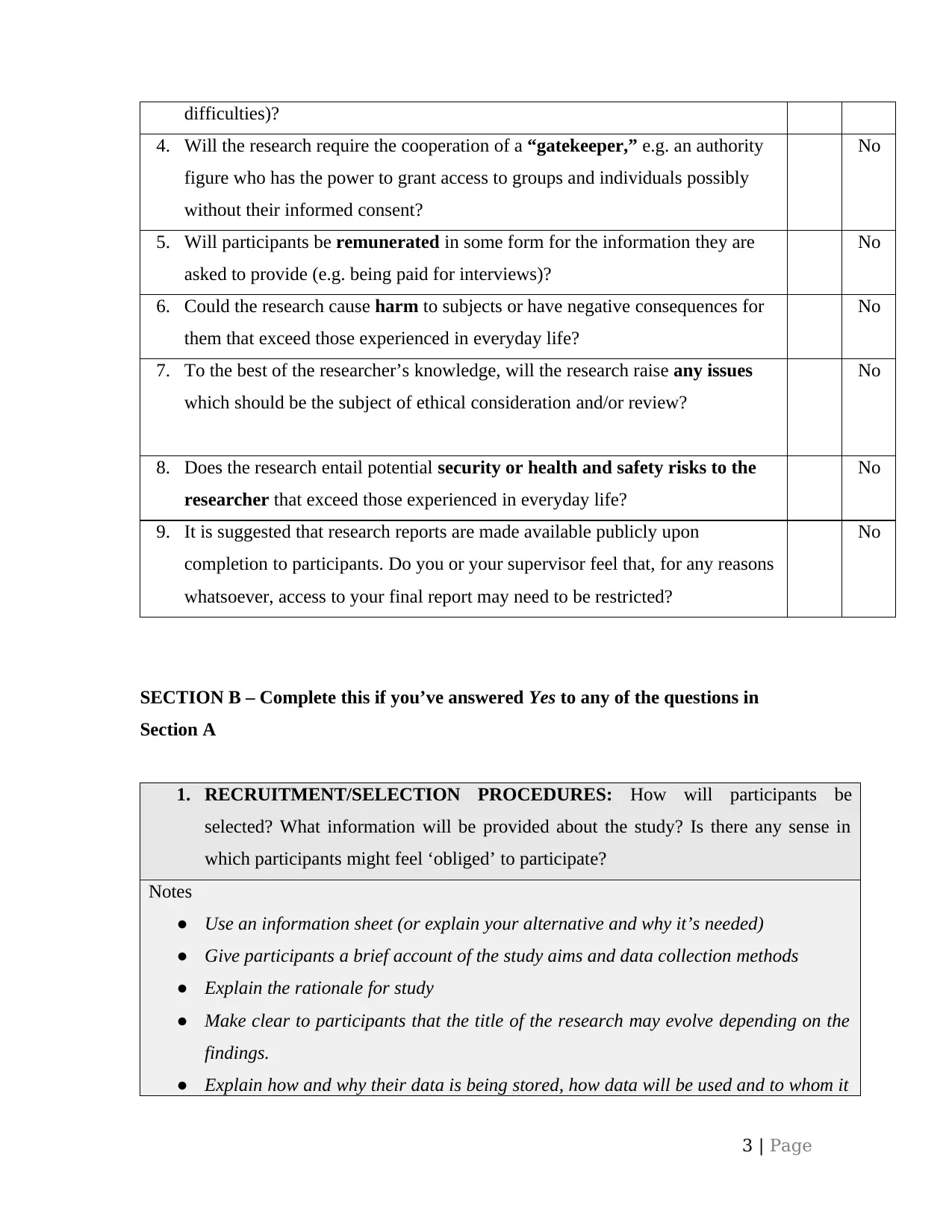
difficulties)?
4. Will the research require the cooperation of a “gatekeeper,” e.g. an authority
figure who has the power to grant access to groups and individuals possibly
without their informed consent?
No
5. Will participants be remunerated in some form for the information they are
asked to provide (e.g. being paid for interviews)?
No
6. Could the research cause harm to subjects or have negative consequences for
them that exceed those experienced in everyday life?
No
7. To the best of the researcher’s knowledge, will the research raise any issues
which should be the subject of ethical consideration and/or review?
No
8. Does the research entail potential security or health and safety risks to the
researcher that exceed those experienced in everyday life?
No
9. It is suggested that research reports are made available publicly upon
completion to participants. Do you or your supervisor feel that, for any reasons
whatsoever, access to your final report may need to be restricted?
No
SECTION B – Complete this if you’ve answered Yes to any of the questions in
Section A
1. RECRUITMENT/SELECTION PROCEDURES: How will participants be
selected? What information will be provided about the study? Is there any sense in
which participants might feel ‘obliged’ to participate?
Notes
● Use an information sheet (or explain your alternative and why it’s needed)
● Give participants a brief account of the study aims and data collection methods
● Explain the rationale for study
● Make clear to participants that the title of the research may evolve depending on the
findings.
● Explain how and why their data is being stored, how data will be used and to whom it
3 | Page
4. Will the research require the cooperation of a “gatekeeper,” e.g. an authority
figure who has the power to grant access to groups and individuals possibly
without their informed consent?
No
5. Will participants be remunerated in some form for the information they are
asked to provide (e.g. being paid for interviews)?
No
6. Could the research cause harm to subjects or have negative consequences for
them that exceed those experienced in everyday life?
No
7. To the best of the researcher’s knowledge, will the research raise any issues
which should be the subject of ethical consideration and/or review?
No
8. Does the research entail potential security or health and safety risks to the
researcher that exceed those experienced in everyday life?
No
9. It is suggested that research reports are made available publicly upon
completion to participants. Do you or your supervisor feel that, for any reasons
whatsoever, access to your final report may need to be restricted?
No
SECTION B – Complete this if you’ve answered Yes to any of the questions in
Section A
1. RECRUITMENT/SELECTION PROCEDURES: How will participants be
selected? What information will be provided about the study? Is there any sense in
which participants might feel ‘obliged’ to participate?
Notes
● Use an information sheet (or explain your alternative and why it’s needed)
● Give participants a brief account of the study aims and data collection methods
● Explain the rationale for study
● Make clear to participants that the title of the research may evolve depending on the
findings.
● Explain how and why their data is being stored, how data will be used and to whom it
3 | Page
⊘ This is a preview!⊘
Do you want full access?
Subscribe today to unlock all pages.

Trusted by 1+ million students worldwide
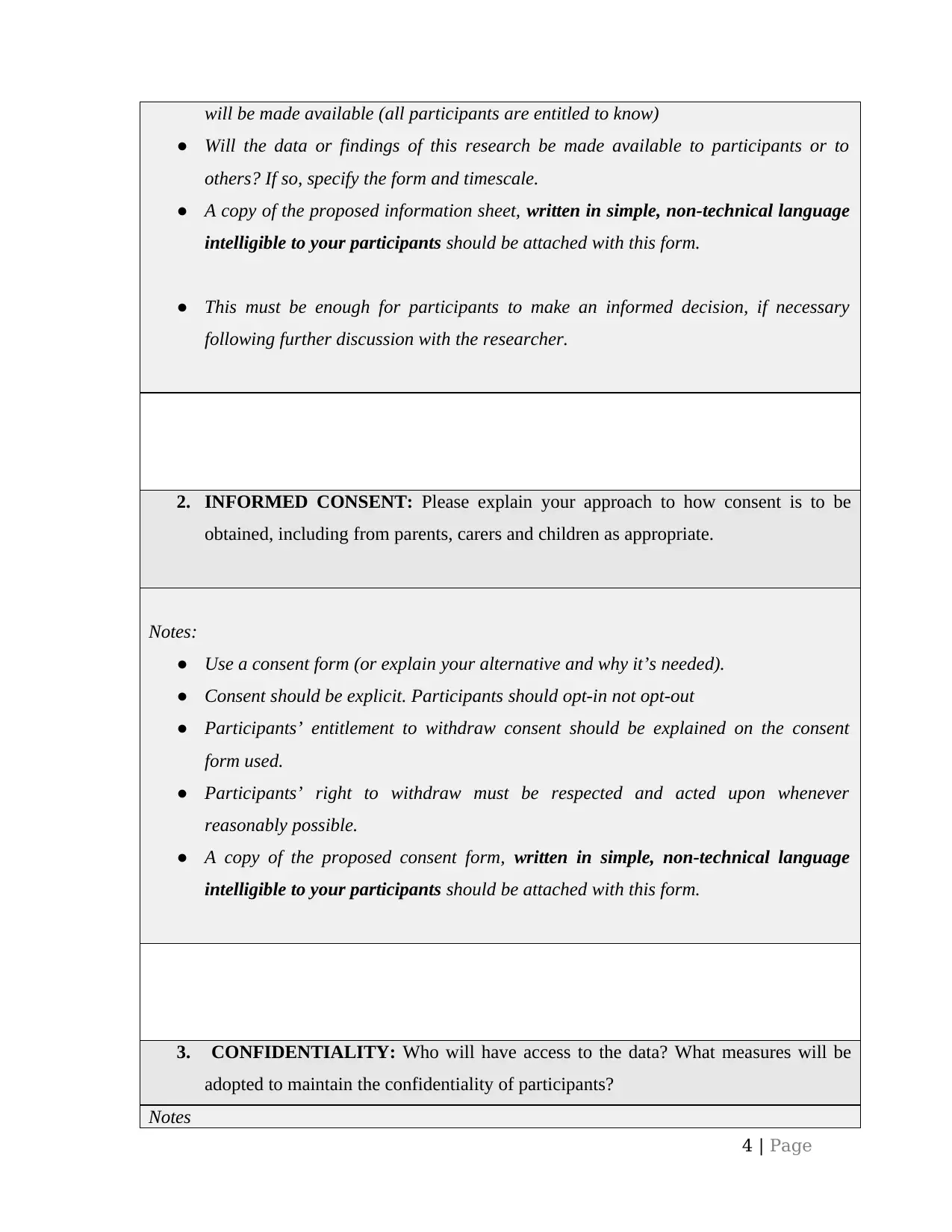
will be made available (all participants are entitled to know)
● Will the data or findings of this research be made available to participants or to
others? If so, specify the form and timescale.
● A copy of the proposed information sheet, written in simple, non-technical language
intelligible to your participants should be attached with this form.
● This must be enough for participants to make an informed decision, if necessary
following further discussion with the researcher.
2. INFORMED CONSENT: Please explain your approach to how consent is to be
obtained, including from parents, carers and children as appropriate.
Notes:
● Use a consent form (or explain your alternative and why it’s needed).
● Consent should be explicit. Participants should opt-in not opt-out
● Participants’ entitlement to withdraw consent should be explained on the consent
form used.
● Participants’ right to withdraw must be respected and acted upon whenever
reasonably possible.
● A copy of the proposed consent form, written in simple, non-technical language
intelligible to your participants should be attached with this form.
3. CONFIDENTIALITY: Who will have access to the data? What measures will be
adopted to maintain the confidentiality of participants?
Notes
4 | Page
● Will the data or findings of this research be made available to participants or to
others? If so, specify the form and timescale.
● A copy of the proposed information sheet, written in simple, non-technical language
intelligible to your participants should be attached with this form.
● This must be enough for participants to make an informed decision, if necessary
following further discussion with the researcher.
2. INFORMED CONSENT: Please explain your approach to how consent is to be
obtained, including from parents, carers and children as appropriate.
Notes:
● Use a consent form (or explain your alternative and why it’s needed).
● Consent should be explicit. Participants should opt-in not opt-out
● Participants’ entitlement to withdraw consent should be explained on the consent
form used.
● Participants’ right to withdraw must be respected and acted upon whenever
reasonably possible.
● A copy of the proposed consent form, written in simple, non-technical language
intelligible to your participants should be attached with this form.
3. CONFIDENTIALITY: Who will have access to the data? What measures will be
adopted to maintain the confidentiality of participants?
Notes
4 | Page
Paraphrase This Document
Need a fresh take? Get an instant paraphrase of this document with our AI Paraphraser
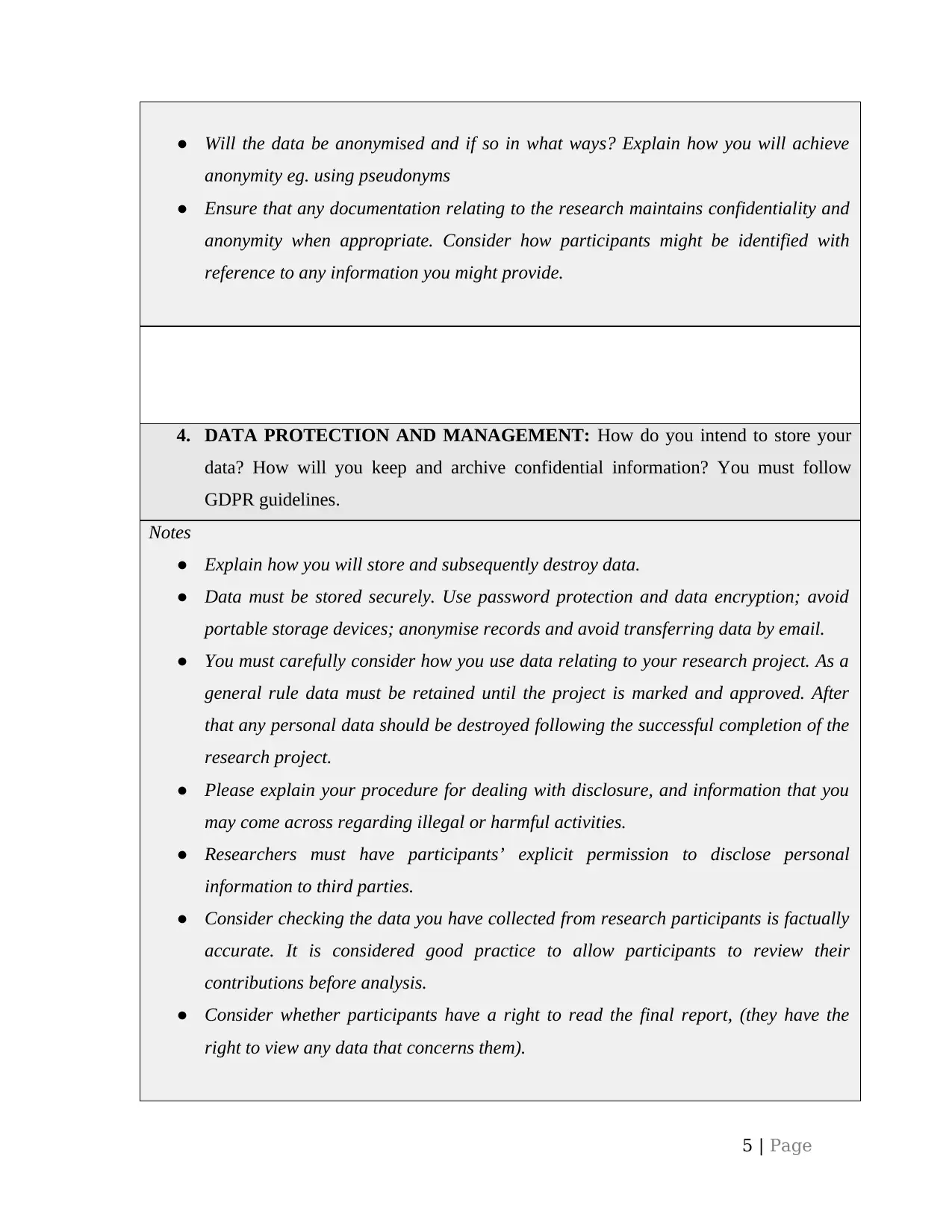
● Will the data be anonymised and if so in what ways? Explain how you will achieve
anonymity eg. using pseudonyms
● Ensure that any documentation relating to the research maintains confidentiality and
anonymity when appropriate. Consider how participants might be identified with
reference to any information you might provide.
4. DATA PROTECTION AND MANAGEMENT: How do you intend to store your
data? How will you keep and archive confidential information? You must follow
GDPR guidelines.
Notes
● Explain how you will store and subsequently destroy data.
● Data must be stored securely. Use password protection and data encryption; avoid
portable storage devices; anonymise records and avoid transferring data by email.
● You must carefully consider how you use data relating to your research project. As a
general rule data must be retained until the project is marked and approved. After
that any personal data should be destroyed following the successful completion of the
research project.
● Please explain your procedure for dealing with disclosure, and information that you
may come across regarding illegal or harmful activities.
● Researchers must have participants’ explicit permission to disclose personal
information to third parties.
● Consider checking the data you have collected from research participants is factually
accurate. It is considered good practice to allow participants to review their
contributions before analysis.
● Consider whether participants have a right to read the final report, (they have the
right to view any data that concerns them).
5 | Page
anonymity eg. using pseudonyms
● Ensure that any documentation relating to the research maintains confidentiality and
anonymity when appropriate. Consider how participants might be identified with
reference to any information you might provide.
4. DATA PROTECTION AND MANAGEMENT: How do you intend to store your
data? How will you keep and archive confidential information? You must follow
GDPR guidelines.
Notes
● Explain how you will store and subsequently destroy data.
● Data must be stored securely. Use password protection and data encryption; avoid
portable storage devices; anonymise records and avoid transferring data by email.
● You must carefully consider how you use data relating to your research project. As a
general rule data must be retained until the project is marked and approved. After
that any personal data should be destroyed following the successful completion of the
research project.
● Please explain your procedure for dealing with disclosure, and information that you
may come across regarding illegal or harmful activities.
● Researchers must have participants’ explicit permission to disclose personal
information to third parties.
● Consider checking the data you have collected from research participants is factually
accurate. It is considered good practice to allow participants to review their
contributions before analysis.
● Consider whether participants have a right to read the final report, (they have the
right to view any data that concerns them).
5 | Page
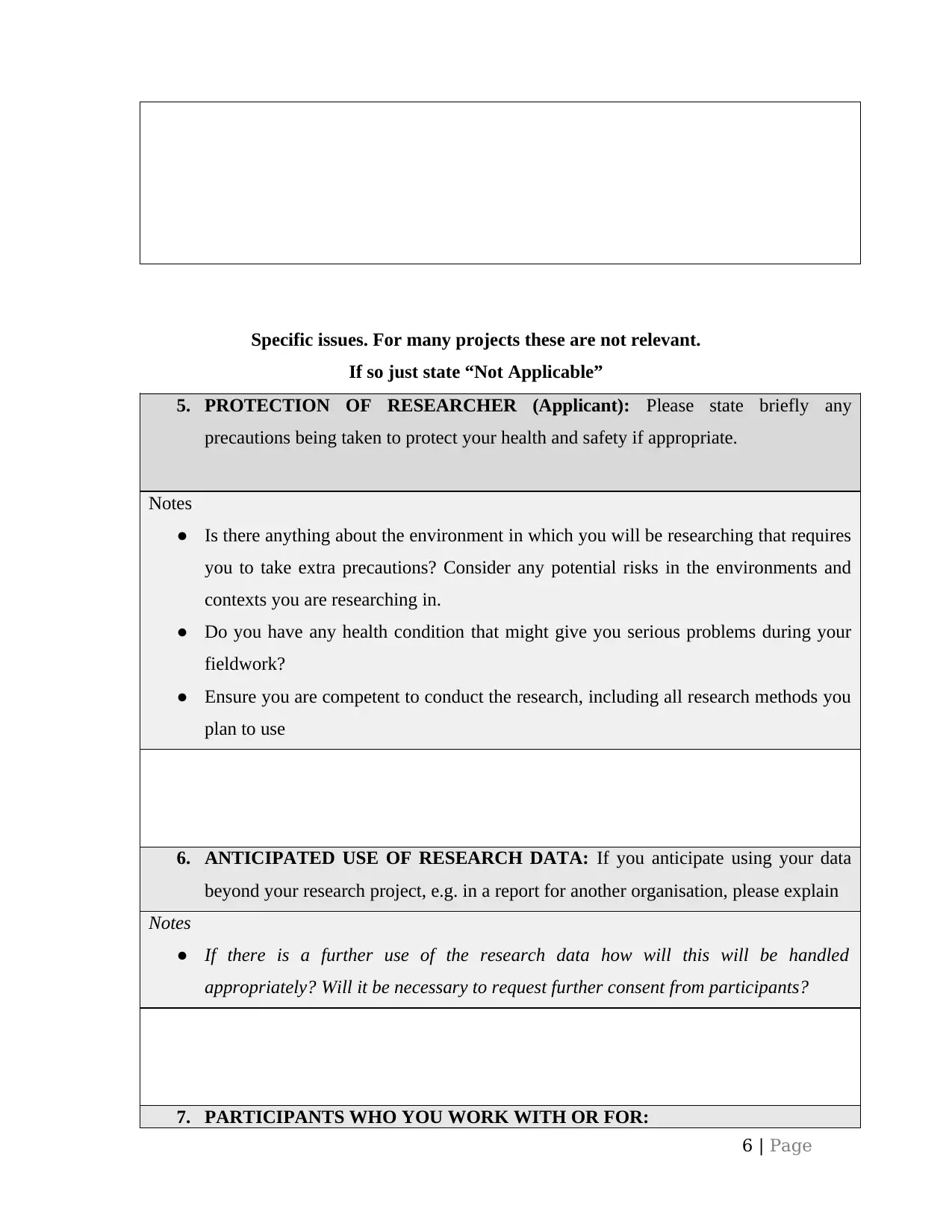
Specific issues. For many projects these are not relevant.
If so just state “Not Applicable”
5. PROTECTION OF RESEARCHER (Applicant): Please state briefly any
precautions being taken to protect your health and safety if appropriate.
Notes
● Is there anything about the environment in which you will be researching that requires
you to take extra precautions? Consider any potential risks in the environments and
contexts you are researching in.
● Do you have any health condition that might give you serious problems during your
fieldwork?
● Ensure you are competent to conduct the research, including all research methods you
plan to use
6. ANTICIPATED USE OF RESEARCH DATA: If you anticipate using your data
beyond your research project, e.g. in a report for another organisation, please explain
Notes
● If there is a further use of the research data how will this will be handled
appropriately? Will it be necessary to request further consent from participants?
7. PARTICIPANTS WHO YOU WORK WITH OR FOR:
6 | Page
If so just state “Not Applicable”
5. PROTECTION OF RESEARCHER (Applicant): Please state briefly any
precautions being taken to protect your health and safety if appropriate.
Notes
● Is there anything about the environment in which you will be researching that requires
you to take extra precautions? Consider any potential risks in the environments and
contexts you are researching in.
● Do you have any health condition that might give you serious problems during your
fieldwork?
● Ensure you are competent to conduct the research, including all research methods you
plan to use
6. ANTICIPATED USE OF RESEARCH DATA: If you anticipate using your data
beyond your research project, e.g. in a report for another organisation, please explain
Notes
● If there is a further use of the research data how will this will be handled
appropriately? Will it be necessary to request further consent from participants?
7. PARTICIPANTS WHO YOU WORK WITH OR FOR:
6 | Page
⊘ This is a preview!⊘
Do you want full access?
Subscribe today to unlock all pages.

Trusted by 1+ million students worldwide
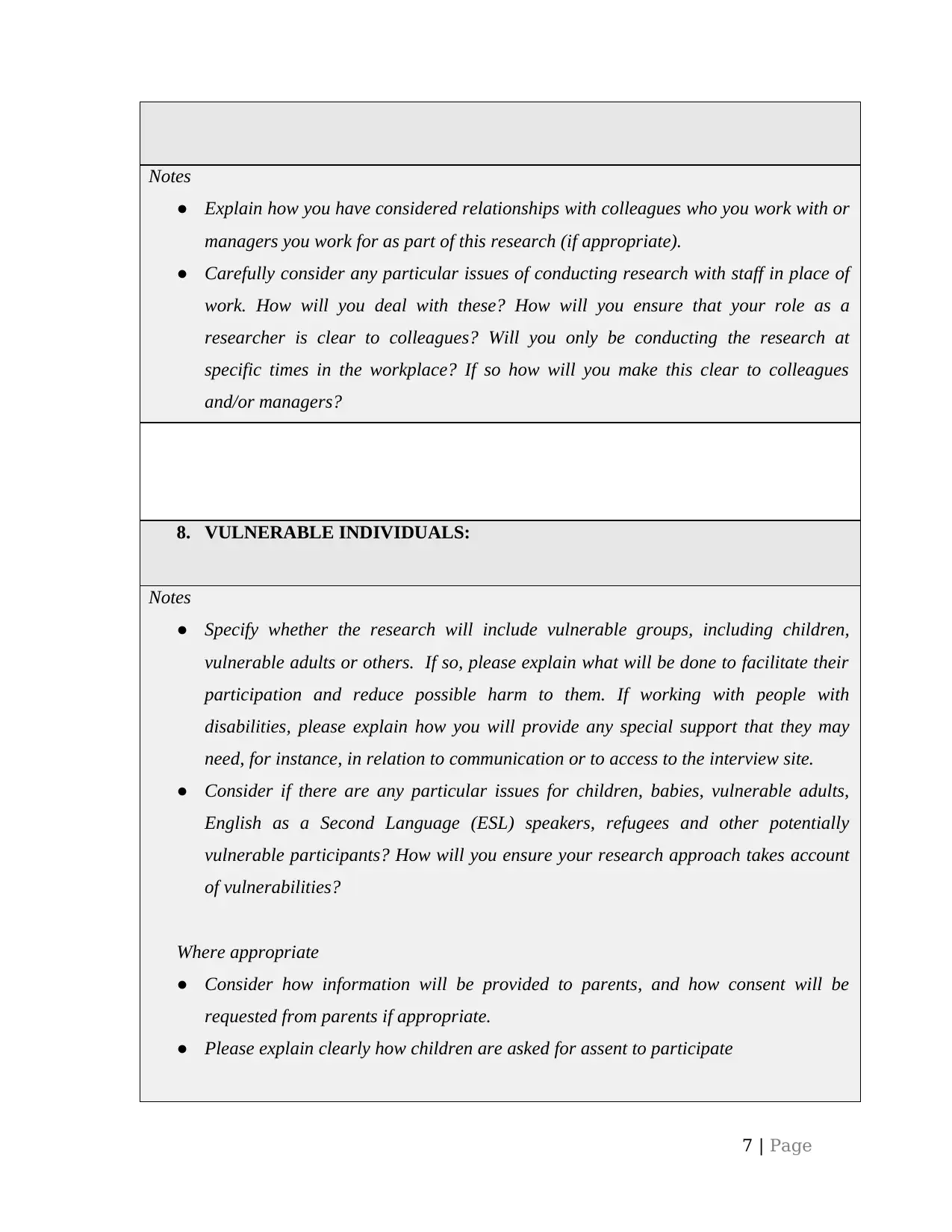
Notes
● Explain how you have considered relationships with colleagues who you work with or
managers you work for as part of this research (if appropriate).
● Carefully consider any particular issues of conducting research with staff in place of
work. How will you deal with these? How will you ensure that your role as a
researcher is clear to colleagues? Will you only be conducting the research at
specific times in the workplace? If so how will you make this clear to colleagues
and/or managers?
8. VULNERABLE INDIVIDUALS:
Notes
● Specify whether the research will include vulnerable groups, including children,
vulnerable adults or others. If so, please explain what will be done to facilitate their
participation and reduce possible harm to them. If working with people with
disabilities, please explain how you will provide any special support that they may
need, for instance, in relation to communication or to access to the interview site.
● Consider if there are any particular issues for children, babies, vulnerable adults,
English as a Second Language (ESL) speakers, refugees and other potentially
vulnerable participants? How will you ensure your research approach takes account
of vulnerabilities?
Where appropriate
● Consider how information will be provided to parents, and how consent will be
requested from parents if appropriate.
● Please explain clearly how children are asked for assent to participate
7 | Page
● Explain how you have considered relationships with colleagues who you work with or
managers you work for as part of this research (if appropriate).
● Carefully consider any particular issues of conducting research with staff in place of
work. How will you deal with these? How will you ensure that your role as a
researcher is clear to colleagues? Will you only be conducting the research at
specific times in the workplace? If so how will you make this clear to colleagues
and/or managers?
8. VULNERABLE INDIVIDUALS:
Notes
● Specify whether the research will include vulnerable groups, including children,
vulnerable adults or others. If so, please explain what will be done to facilitate their
participation and reduce possible harm to them. If working with people with
disabilities, please explain how you will provide any special support that they may
need, for instance, in relation to communication or to access to the interview site.
● Consider if there are any particular issues for children, babies, vulnerable adults,
English as a Second Language (ESL) speakers, refugees and other potentially
vulnerable participants? How will you ensure your research approach takes account
of vulnerabilities?
Where appropriate
● Consider how information will be provided to parents, and how consent will be
requested from parents if appropriate.
● Please explain clearly how children are asked for assent to participate
7 | Page
Paraphrase This Document
Need a fresh take? Get an instant paraphrase of this document with our AI Paraphraser
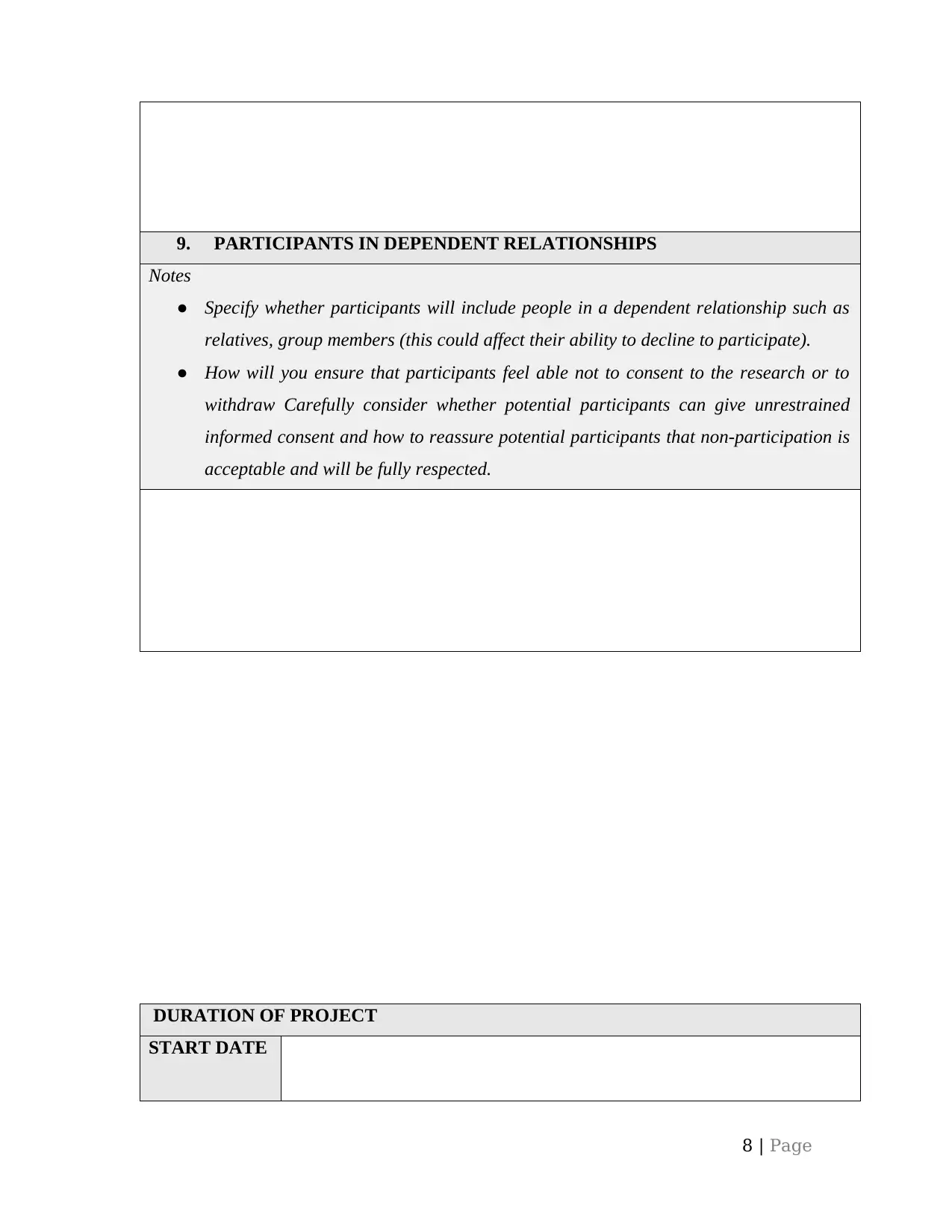
9. PARTICIPANTS IN DEPENDENT RELATIONSHIPS
Notes
● Specify whether participants will include people in a dependent relationship such as
relatives, group members (this could affect their ability to decline to participate).
● How will you ensure that participants feel able not to consent to the research or to
withdraw Carefully consider whether potential participants can give unrestrained
informed consent and how to reassure potential participants that non-participation is
acceptable and will be fully respected.
DURATION OF PROJECT
START DATE
8 | Page
Notes
● Specify whether participants will include people in a dependent relationship such as
relatives, group members (this could affect their ability to decline to participate).
● How will you ensure that participants feel able not to consent to the research or to
withdraw Carefully consider whether potential participants can give unrestrained
informed consent and how to reassure potential participants that non-participation is
acceptable and will be fully respected.
DURATION OF PROJECT
START DATE
8 | Page
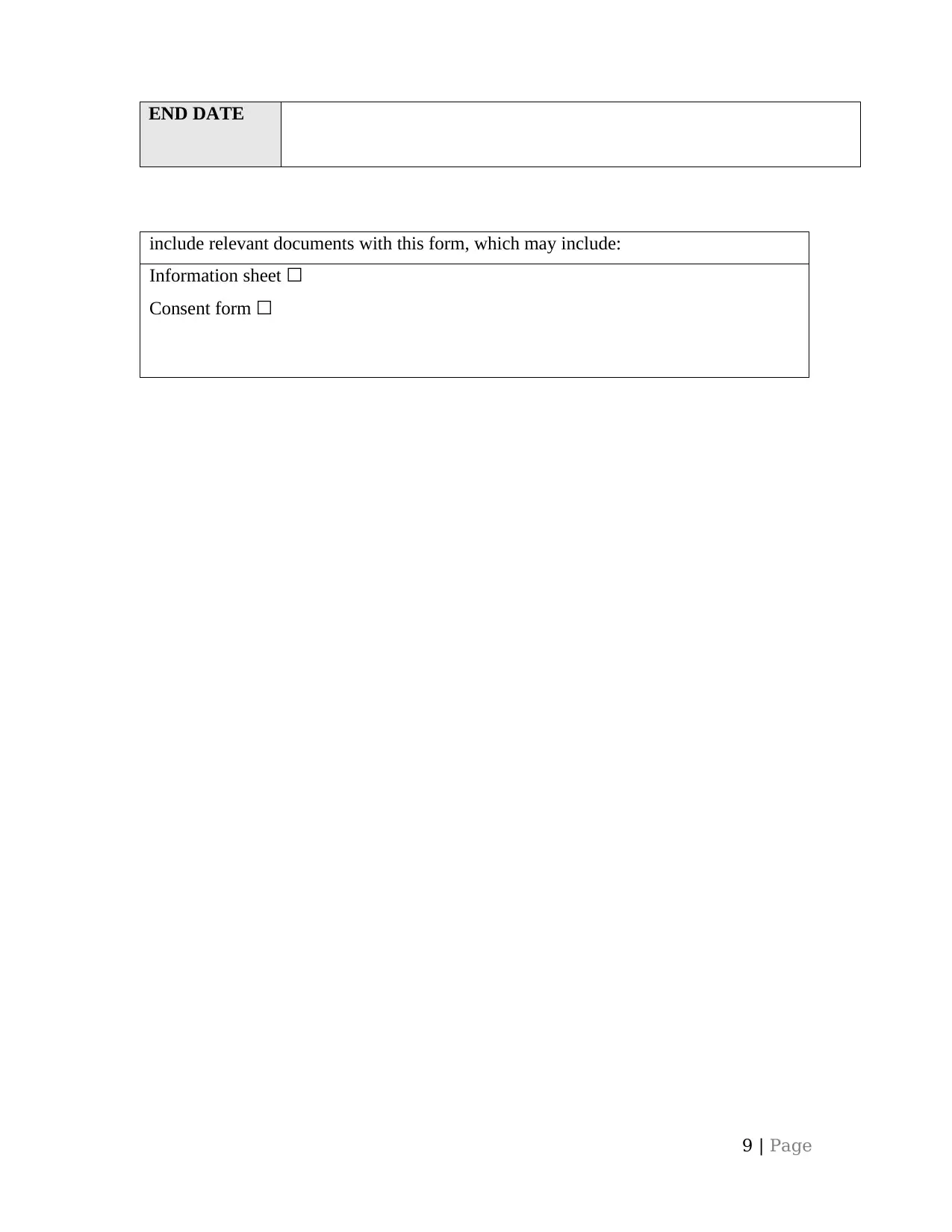
END DATE
include relevant documents with this form, which may include:
Information sheet ☐
Consent form ☐
9 | Page
include relevant documents with this form, which may include:
Information sheet ☐
Consent form ☐
9 | Page
⊘ This is a preview!⊘
Do you want full access?
Subscribe today to unlock all pages.

Trusted by 1+ million students worldwide
1 out of 9
Related Documents
Your All-in-One AI-Powered Toolkit for Academic Success.
+13062052269
info@desklib.com
Available 24*7 on WhatsApp / Email
![[object Object]](/_next/static/media/star-bottom.7253800d.svg)
Unlock your academic potential
Copyright © 2020–2025 A2Z Services. All Rights Reserved. Developed and managed by ZUCOL.





